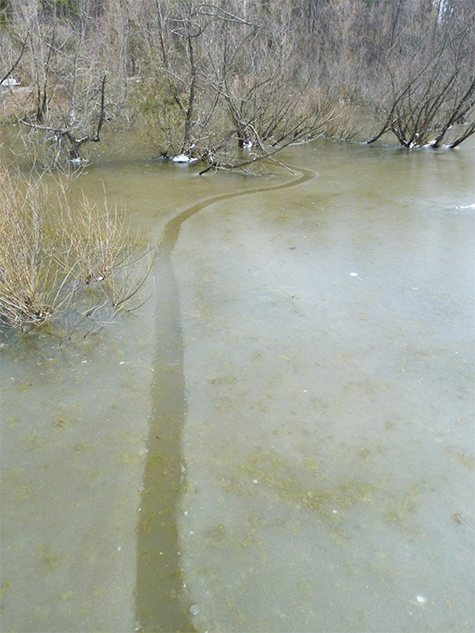
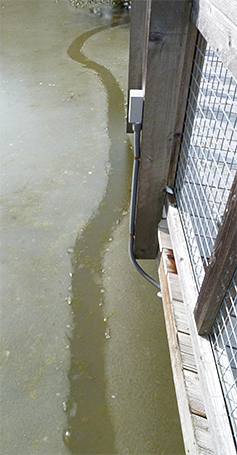
As I stood on the Main Wetlands Overlook, I noticed a track of smooth ice coming from the willows on the north side of the Wetlands and heading directly towards the platform on which I stood. The track was frozen over, but frozen over more recently than the surrounding ice. Obviously, some creature had swum through the ice when it was slushy, creating a trail and the trail had subsequently frozen over.
I looked over the rail at the front of the overlook. The trail skirted the outside of the platform and around a small island a few feet from the platform.
From there, the trail went out across the pond towards the island that hosts a wood duck nest box, and abruptly stopped.
What creature had made this track through the ice and why had the track suddenly stopped partway across the water? Whatever made the track either dove under the water at that point or exited the water via the air, beaver? otter? goose?
But first, maybe there was a clue on the other side of the willows, where the tracks started. Maybe there were some tracks in the mud or snow at the edge of the water, perhaps even some scat.
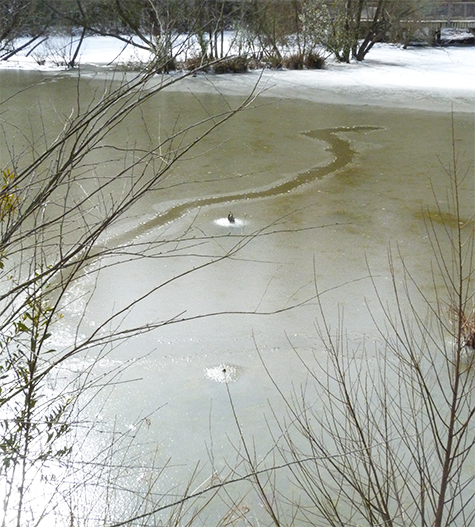
From the path on the north side of the Wetlands I could see an area of water that had been kept open by whatever it was that left the track. There was an area approximately 50 feet by 20 feet that had been disturbed and had refroze. Something had been swimming about foraging for food in the shallow water.
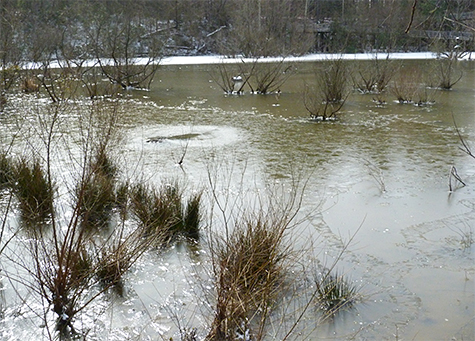
There were also individual tracks branching off from the main area of refrozen water (ice).
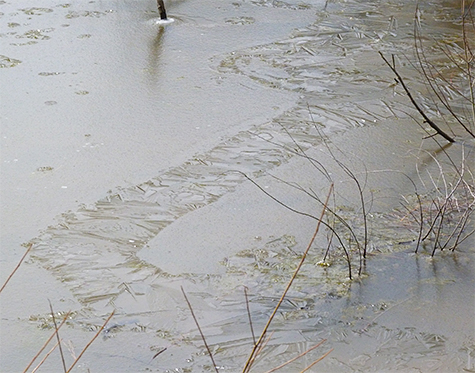
I saw no tracks in the snow or mud at the edge of the water. There were no signs of beaver, no gnawings of any kind. But, there was one piece of scat, goose scat, on the path about six feet from the water.
Back to the Wetlands Overlook and more clues.
I was hoping that the track was from an otter and that I would find sign, in the form of a foot print or scat somewhere around the Wetlands. Who doesn’t like otters. However, I found nothing that suggested otter, other than the fact that whatever had been swimming in the Wetlands had possibly dived underwater at the end of the track. An otter is no stranger to underwater travel, they spend most of their lives in and under water.
The way the track ends is curious. Looking at the above photos, you’ll notice that the track is smooth sided, not necessarily straight, but relatively narrow and with a purpose. Towards the track’s end (below) there is a zig-zag, as if the creature that made the track was indecisive, which way should I go or what should I do now.
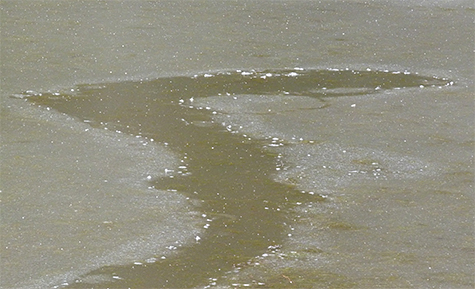
Canada geese typically need a running start to become airborne, on land or in the water. They can, however, take off from a standstill when pressed. It looks to me as though there were two geese swimming along (our resident geese), one after the other, trying to find a way out of the ice, which was apparently closing in on them. Most birds, when feeling cornered or threatened will look this way, then the other, take a step this way, then that way, or swim this way then the other before finally bolting.
Our geese couldn’t run across the ice to get enough speed for flight (the ice was either too thin to hold their weight or too slippery to get traction) so they swam this way, then that way, probably cackling the whole time, trying to make up their minds as to what to do. They obviously couldn’t spend the night here on this frozen pond. They needed open water on which to spend the night, floating safely away from any land-based predators, like fox, coyote, or even stray dogs.
Finally, out of desperation they launched straight up into the air and out of the dilemma they had found themselves in. I doubt the geese were in imminent danger, but they obviously felt that they needed to leave this place before the entire pond was a solid sheet of ice. And so they did.